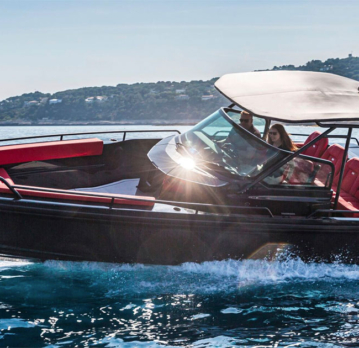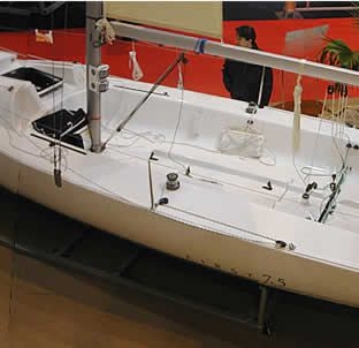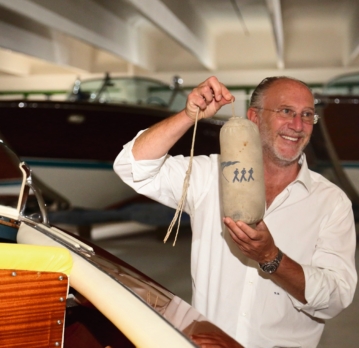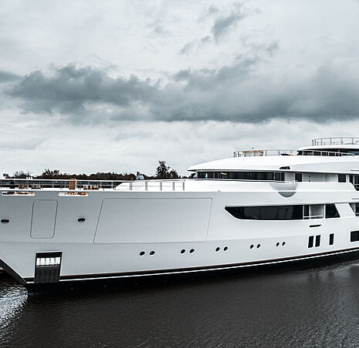
The first synthetic plastic — bakelite — was received by Leo Bachelordom in the distant 1907. Simple manufacturing, relatively low cost, versatility and many variations have allowed plastics to instantly gain popularity in many areas. But his age is slowly coming to an end and are replaced by other materials.
Visible progress in the yachting industry today provides freedom in design and is dictated by the flourishing electronics the total dominance of “the numbers”, but sooner or later we will have to change steel, aluminum and fiberglass for something else. According to some projections, the plastic will end with the oil, and stocks of iron and aluminum runs out already in this century, which will inevitably increase prices on their products. Although aluminum and steel with a high degree of processing (60 and 70%, respectively), recyclable materials are still not enough to fully close the demand for these materials now and in the future: these days, recycled metal is only a third of the products.


- LignoTUBE — durable thin-walled tubes from veneer with a diameter of 20-120 mm
Every day on Earth is born with about 250 000 people, while the world is dominated by countries that consume more material resources than the planet can reproduce. The preservation of ecological balance is not the only reason for the transition to the new materials from renewable resources. There are at least two reasons: first, through innovation in this area it is possible to solve a number of urgent engineering problems, and secondly, new materials, new clothes, create a feeling of positive change and shape the environment that are beneficial to humans.
Anything you want
Looking at the website of the company MaterialDistrict, where he created perhaps one of the most interesting bases on the subject, amazed at what products sometimes find use as building materials. Pressed Newspapers, mollusk shells, thallus algae, eggshells, mycelium, tobacco leaves… Can be found such Exotica as PU leather, mushrooms or fruit, bioplastics from the waste of cheese making or composites based on walnut shell.
Have you ever thought about to use to finish the kitchen panels made from… coffee? “The Dutch drink coffee in Europe: 50 kg per year per person, says ELS Zijlstra, creative Director MaterialDistrict. — Removing of the bean taste, we throw cake, but if it is dried and mixed with a biodegradable polymer resin, obtained excellent material, which also retains the aroma of coffee. Or, for example, mango — every day in the world throw a huge amount of these fruits is due to the fact that they appear black dots; but of mango makes an excellent eco-friendly leather”.

- Composite glass panels Sensitile with complex internal structure are ideal for various kinds of partitions

- As a finishing material with a pronounced texture can be painted leather salmon
Most of the presents MaterialDistrict solutions, including exotic, have long been out of the stage of development, and of greatest interest for the conservative yacht industry present composite materials based on wood. If an ordinary tree in the form of solid fragments of trunks are flammable and behaves unpredictably if you change the humidity, composite wood in our days erected even skyscrapers. So, laminated timber of Douglas fir (Douglas fir) with cross laying of layers is 3.5 times stronger than steel, and if it burns, slow and predictable. A number of shipyards already attempts to replace the disappearing and rising in price tick in acetylated wood: processing of fast-growing varieties of soft wood in non-toxic concentrated acetic acid for nearly half a century to protect it from decay.
Another promising direction — giant bamboo: it grows up to 20 meters in just 4 years, and the materials from this plant are increasingly used in decorative and other purposes. So, the ceiling in the fourth terminal of Madrid Barajas airport is covered with a bamboo laminate with a total area of 200 000 sq m; the automakers are decorated with bamboo interiors of the models of premium brands, while in Amsterdam preparing to replace metal traffic signs on bamboo.

- Eco-friendly, waterproof, resistant to environmental PU leather, silicone

- Flexible Acoustic cover Wool Felt Flex substrate consists of a felt (100% wool) and Plexwood veneer, which provide high noise insulation

- Panel Oesterplat represent artificial marble with inclusions of oyster shells
“I believe in the future of structural materials based on bamboo, says ELS Zijlstra. After some processing, it does not rot, does not support combustion and is resistant to moisture. Pressed bamboo is harder than most hard wood, it turns into plastic, and its performance many times better. Made of pressed bamboo already today it is possible to build yachts and buildings.”
Another interesting eco-friendly material — cork. It comes mainly from Portugal, where the production of plugs for wine bottles depended on the welfare of many people. With the advent and proliferation of plastic and screw manufacturing had to restructure, and now from the bark of the cork oak is used to make decking, insulation materials and even textiles.
 ELS Zijlstra, creative Director MaterialDistrict:with regard to the use of fiberglass for the production of yachts, it is still very difficult to find an alternative material with the same qualities, and most importantly — price. Therefore, it remains to wait for his ban or come up with an inexpensive eco-friendly replacement. While bioplastics is too expensive, in addition, the shipyard used to work with fiberglass, and while most people buy these boats, they won’t go to something new and unknown.
ELS Zijlstra, creative Director MaterialDistrict:with regard to the use of fiberglass for the production of yachts, it is still very difficult to find an alternative material with the same qualities, and most importantly — price. Therefore, it remains to wait for his ban or come up with an inexpensive eco-friendly replacement. While bioplastics is too expensive, in addition, the shipyard used to work with fiberglass, and while most people buy these boats, they won’t go to something new and unknown.
One of the most striking examples of failure from plastic in favor of modern timber stands unique Foggy sailboat, designed by famous architect Frank Gary at the American shipyard, Brooklin Boat Yard in 2015. The basis of this model yacht Frers 74, and her body is a composite-based foam, covered with wood of the highest grade and have a lot of titanium and carbon elements. Its outer skin consists of two glued under vacuum diagonal layers of canadian red cedar, a thick layer of Western larch and layer are laminated using the infusion biaxial carbon fibers.
Be Smart!
A separate group consists of so-called smart materials, significantly changing their properties under the influence of environmental factors. In the aerospace and automotive industries have long conducted studies of coatings is able to “heal” the corrupted structures of conventional isotropic materials like steel and aluminum, which, of course, important in shipbuilding.
Innovative photovoltaic paint capable of turning the surface of the add-ins into one big solar battery, replacing is not always fit into panel design. The next step is a thermoelectric coating on the basis of bismuth telluride, which transforms thermal energy into electricity, which can take on some tasks on supply vessels in regions with a hot climate where summer dark surfaces can heat up to +50 °C or more. Finally, to get to produce electricity is not only the superstructure but the hull. You have to integrate in the coating of the piezoelectric cells that will produce energy from shock waves. Of course, this method does not allow to cover all the needs of the vessel, but when properly designed system can, for example, to support the work of emergency of navigation equipment in case of blackout on the stormy sea.
To make life easier for the crew, forced to constantly kick boat, can self-cleaning coating includes titanium dioxide, well known artists and white pigment is Titanium White. Being one of the most effective photocatalytic agents when exposed to light in the presence of water vapour it catalyzes the oxidation reactions involving hydroxyl radicals and superoxide anions, with the result that at room temperature form carbon dioxide and water. This clever and easy-care protection will help fight dust, salt, mildew and oil-pollution, especially on glass surfaces.

Another significant trend is the materials that emit or transformerait light. Some of them rely on the effect of total internal reflection, which is widely used in fiber optics. So, for example, tubes made of PMMA, enclosed in any matrix or organized by themselves, capable of capturing light from the illuminated area and spend it in the shade without the use of energy. A similar effect is created by glass “svetopribor”, which, along with acrylic, give you the opportunity not only to save electricity, which is very important on Board, but also open new horizons for designers ‘ creativity.
The desire or the law?
The abundance of promising materials does not mean that the shipbuilding industry will immediately take them on Board. This industry is highly regulated worldwide and the registers are reluctant to accept new materials, demanding from the manufacturers a lot of additional tests. On the one hand, their rules “written in blood”, but on the other, two thirds of innovations are somehow connected with materials with new, better properties, and to cling to “old-fashioned” is not always justified.

“The rate of adoption of new materials the yachting industry is extremely low, says ELS Zijlstra. — Experience shows that the first of their adopting the defense industry, aerospace and sports industry who, by the way, being competitive, and largely provide for the financing of their development. In other areas of research in this direction, companies spend an average of about 10% of turnover, while, for example, in architecture, the figure is only 2.5%, so innovations come here very slowly and with great difficulty.
In the yachting industry, which combines rest and sport, the situation is somewhat better, but, in my opinion, the pace is still insufficient. Maybe the shipyard just don’t know about new materials or waiting for them to come into fashion. Designers are more enterprising, but customers are not in a hurry, and the reasons are many. Partly plays the role of that boat, especially a small one, is a way of demonstrating social status, and then still go the traditional concepts of luxury. Brave people, willing to go against the stereotypes and show that they care about the environment and what they are willing to use at least comfortable and high quality innovative materials of class “Lux”, very little. Therefore, I believe that the main obstacle is low awareness that must still be overcome for the new generation of yacht owners.
Also the choice depends on the culture: someone sets out on the boat, solar panels to burn less fuel and produce fewer emissions, while someone is drinking whiskey for a few tens of thousands of euros because he did not know what to do with the money. It is clear that when one pays millions for a new yacht, he is probably not psychologically ready to see the interior finishing panels from recycled Newspapers, but I think if we see at least one such example, something will budge.
Fashion on the “right” materials over time, or otherwise formed, and now we are at the beginning of the transition period. One of the few ways to help innovative content to spread is the adoption of new laws. If the ban “dirty” materials, people will not remain anything else how to switch to “clean.” In the Netherlands this approach is already practiced in construction when new buildings are obliged to build from environmentally neutral materials.”
The name of the Pharaoh
In the framework of the EU programme Horizon 2020, recently launched a project RAMSSES (Realisation and Demonstration of Advanced Material Solutions for Sustainable and Efficient Ships) aimed at stimulating the adoption by industry of innovative and sustainable materials in commercial shipbuilding. Shipyards, equipment suppliers and shipping companies often do not know or are unsure of the long term qualities of new materials, I doubt the economic feasibility of their use, which leads to substantial technological gap in the industry. To solve this problem, RAMSSES has established 13 demonstration projects to show the diversity of innovative materials, their potential and possibility of application in shipbuilding. To show the practical benefits for each project have been or will be created a fully working prototype.

- The company Ecovative Design “grows” and develops innovative materials from mycelium
Another difficulty stems from the fact that new materials often has no statistical data for testing in different conditions throughout the life cycle, and their approval by classification authorities occurs individually in each specific case, which requires additional time and money. Moreover, the situation is aggravated by the lack of intersectoral systematic exchange of knowledge on this issue and the difficulty of access to information on new materials, with the result that engineers just don’t know what is possible now. That is why RAMSSES set about creating a “Platform of marine innovation,” which will facilitate the dissemination of knowledge and will incorporate the methodology and results of tests of new materials, as well as experience using them on existing vessels.
Among the demonstration projects RAMSSES are propellers of copper-aluminum alloys, martensitic and dual-phase steel using additive technologies; lightweight rudder blades, made of several materials; modular lightweight fireproof sound insulation panel truss to the bulkhead and Podbolotov; lightweight deck of high-alloy steel, etc. this list shows that one of the main tasks of RAMSSES is that due to lightweight components made of modern materials to reduce the weight of the courts, and among participants in the project include such well-known companies like Damen, Fincantieri, Meyer Werft and Baltic Workboats.
 Summary
Summary
Recent marketing research by Unilever has shown that a third of customers prefer to buy goods of those manufacturers who do not remain indifferent to social and environmental issues. In the developed Western countries, this trend is obvious. Sooner or later it will cover more people and spread to the entire educated world. In the yachting industry transition to the new materials is largely driven by producers of interiors and finishes that offer designers and shipyards fresh solutions. And if now the choice is in their favour — the decision is voluntary, it is not excluded that in the near future there will be a legislative regulation of their share in the total mass used on the ship material.
materialworld













What do you think?